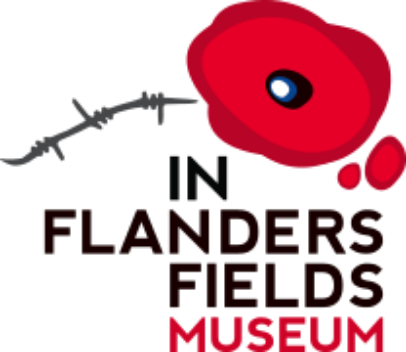Music & War
handwritten music, notes and lyrics

three church hymns
In the rubble of the church of St Nicholas in Ypres, gunner William Wilkins found a page of three hymns: Psalm 140, Sub tuum praesidium, and in between the Salve Regina by the Austrian composer Anton Diabelli (1781-1858).
Wilkins was on the front line at Ypres both in the spring of 1916 and in October 1917. His unit, the 5th Brigade Royal Field Artillery, was loaned to the Canadian Expeditionary Force in late 1915. In April 1918 he was wounded during a gas attack near Loos (Pas-de-Calais) but was to survive the war.
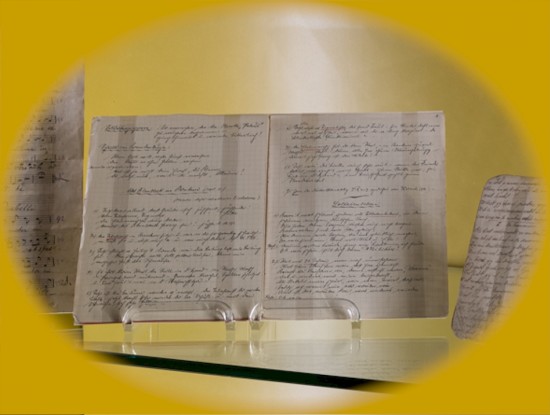
song texts in diaries (I)
In an appendix to a diary, a German soldier, unknown at the time, recorded the titles of "what is read in the field" and a series of "comic songs". He wrote 'Soldatenleben' in Hooglede on Christmas day 1917, 'Marmelade' in January 1917.
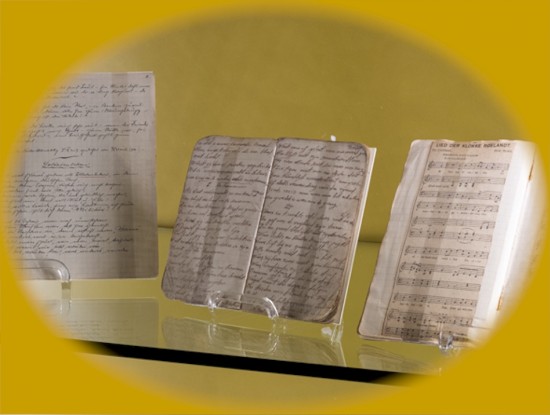
song texts in diaries (II)
The Belgian soldier Remi Verwaerde was at the front from 28 June 1915 to 15 April 1916, after which he stayed in various military hospitals in France until 1918. In a small notebook he kept mainly addresses but also song texts, such as 'De Vrouwen van Bachten de Kupe' or 'Een jongeling op het slagveld'.
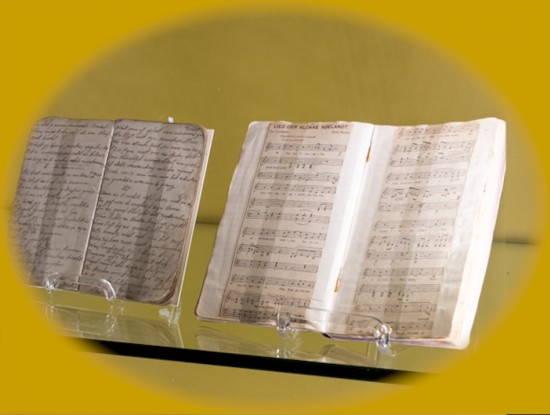
song texts in diaries (III)
The Belgian stretcher bearer and nurse Armand Luchies kept a diary from the beginning of the war until the end of 1916. Now and then he stuck song texts or scores in his diary. He died of bronchopneumonia on 9 August 1918 in the southern English city of Bath. The diary opened with the score of 'Ik ken een lied' by W. De Mol and G. Antheunis, translated into English as 'The Old Man's Song'. The clippings are from 'De Stem uit België - L'Echo de Belgique', a newspaper for refugees published in England.
trench mandolin
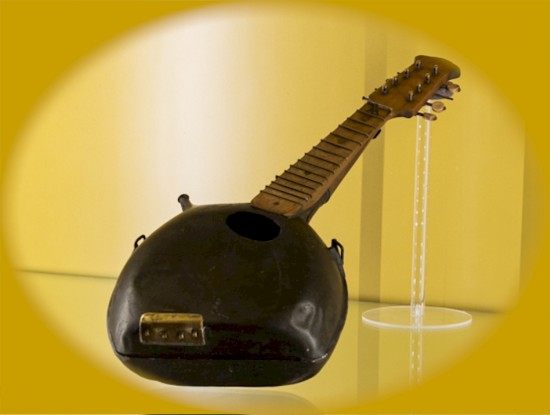
A French drinking bottle served as the sound box for this original mandolin, while the neck of an existing instrument was reused. Instrument builder Hugo Valcke built a new instrument that was played by Wiet Van de Leest for a recording for the Bloody Fields of Flanders.
flemish 'bumblebees'
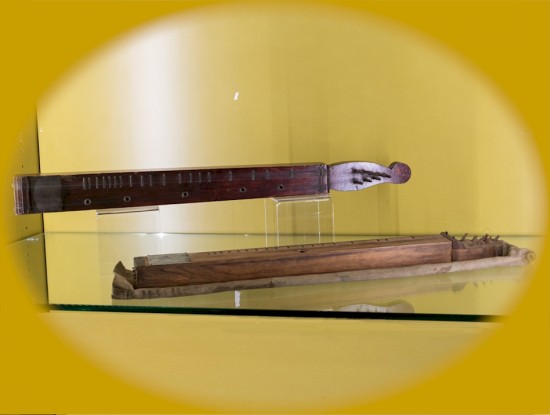
In the Low Countries, a plankciter is called a 'bumblebee' (hummel) or an 'elder'. On one instrument an aluminium plate - a feat of trench art - mentions the name "Van Driesse" and "Yser." The other one belonged to Ludovicus van Dijck.
gramophone

The portable gramophone was an invention from shortly before World War I and brought music to the trenches. Some proved remarkably durable: a British "Decca" device was once reported to have been hit by a shell, but the soldiers were delighted to find that "the old gramophone was still going strong!"
This Decca Dulciflex 'Trench' (table model) gramophone is in excellent condition. A needle can be inserted without any problem, the internal spring can be turned up with the crank and the sound of a cracking record will resound.
the accordion player
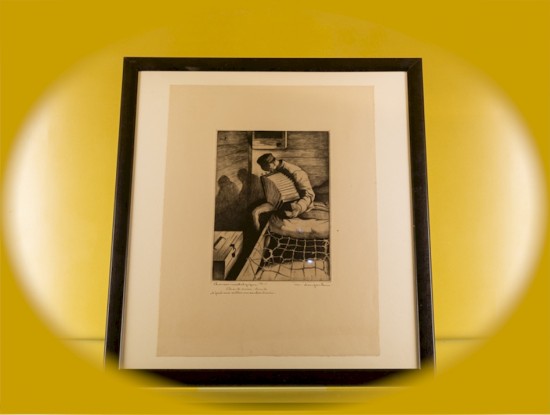
"Chanson nostalgique:
Chante encore, chante et fait moi oublier mes sombres rêveries."
A Belgian prisoner of war sits on the edge of a bed and plays the accordion.
Etching by Maurice Langaskens (1884-1946)
harmonicas

diatonic accordion
This diatonic accordion was made in Brive (Corrèze, France) in the workshop of François Dedenis (1866-1933). The instrument belonged to Jan Leopold Beckers, soldier in the 1st Regiment Grenadiers.
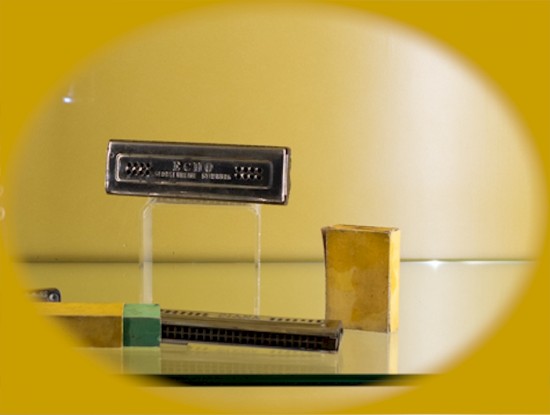
mouth organs
"Christmas 1914 remains unforgettable for me. Between the trenches, enemies stood around the Christmas tree singing songs together. An Englishman played the harmonica of a German comrade."
(Josef Wenzl, 16. Reserve-Infanterie-Regiment)
sheet music and publications
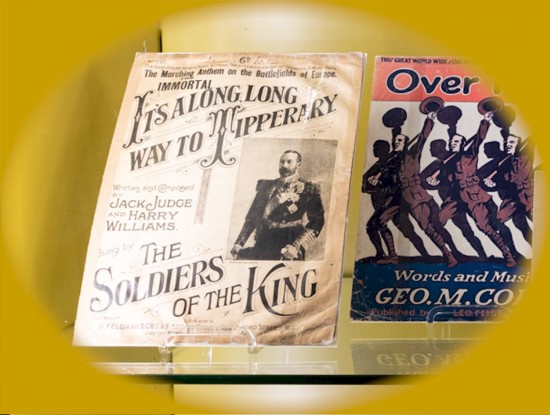
It’s a long way to Tipperary
(Jack Judge & Harry Williams, 1912)
American reissue of the well-known Irish/British music hall song that made little impression when it first appeared in 1912, but was picked up by the marching troops of the British Army at the beginning of World War I, and became one of the best-known marching songs of the war.
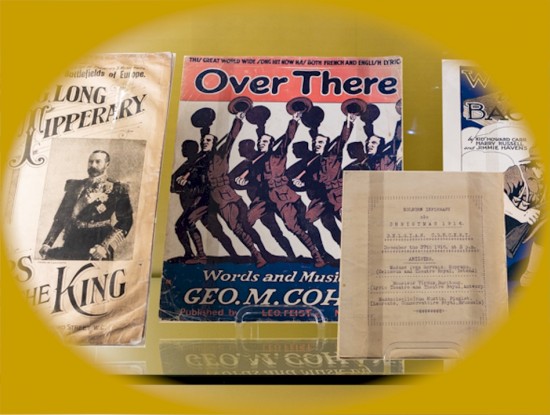
Over There
(George M. Cohan, New York, 1917)
Written by Broadway producer, singer and author George M. Cohan in April 1917, after learning that the USA would join the war after all. The patriotic song became very popular both in the USA and at the front, including early recordings by Nora Bayes and Enrico Caruso in 1917. A French text "Par là-bas" by Louis Delamarée was soon added. This is the bilingual edition from 1918.
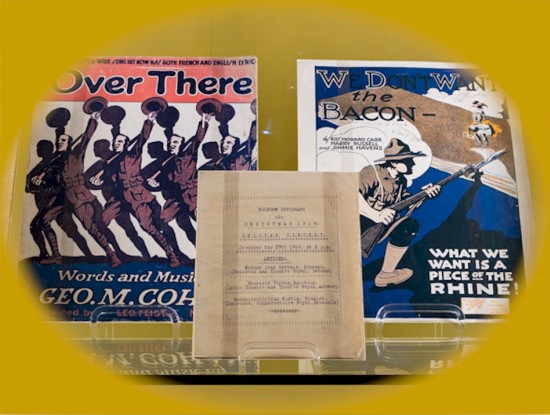
Belgian Concert, Xmas 1916
Programme of a benefit concert in the Holborn Infirmary in Highgate, London. The concert was performed by Belgian refugee musicians, including the well-known bass-baritone M. Viroux, who was associated with the Antwerp opera.
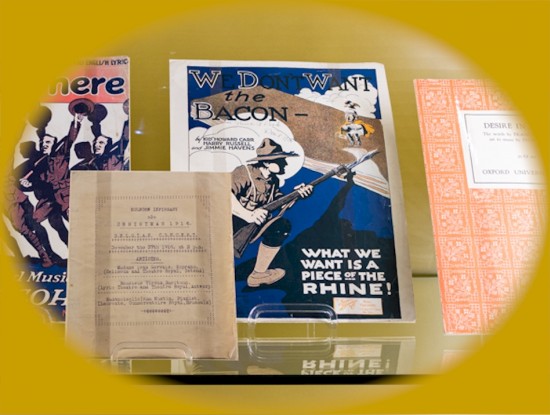
We don’t want the Bacon
(Howard Carr, Harry Russell & Jimmie Havens. New York, 1918)
This song was written at the end of the war, and dedicated to Lieutenant Joseph Foley, US. Army. It was purchased by Nina G. Peck on December 8, 1918. On 4 August 2014, Lester Simpson donated this score to Piet Chielens, as a memento for the years of cooperation for Peace Concerts Passchendaele and for the In Flanders Fields Museum. Piet donated it to the museum on the occasion of this exhibition.

Desire in Spring
(Francis Ledwidge – Ivor Gurney, 1918/1928)
The Irish poet Francis Ledwidge fell in Boezinge on 31 July 1917, as a Lance Corporal in the 1st Bn. Royal Inniskilling Fiusiliers. The English poet and composer Ivor Gurney arrived at the Third Battle of Ypres a month later as a Private in the 2/5th Gloucestershire Regiment. He was wounded in a gas attack on 12 September 1917 and evacuated to England. At the end of 1918 Gurney composed music to Ledwig's poem 'Desire in Spring'. It was not until ten years later that it was published by OUP. It was one of at most 20 songs published during Gurney's lifetime. From 1922 until his death in 1937, Ivor Gurney stayed in a mental institution. A part of his literary and musical oeuvre remains unpublished until today.
German zither
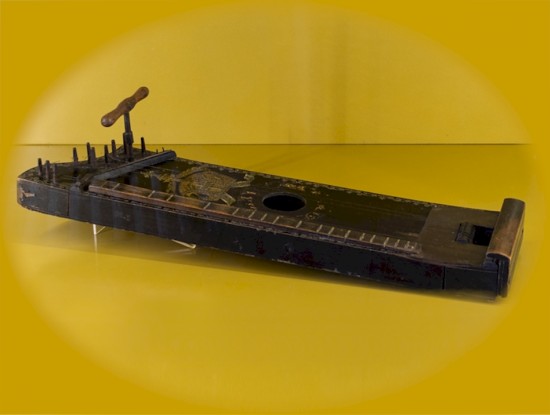
txt
strings
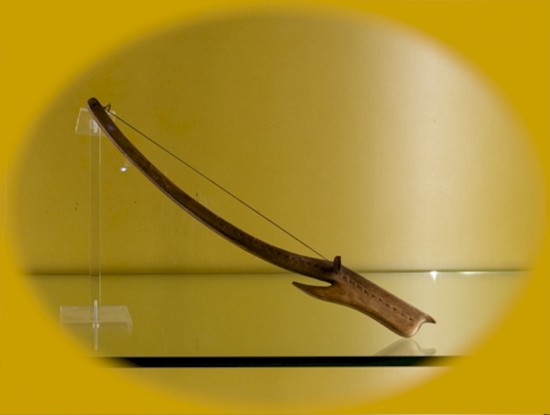
bow
Self-made bow used to strike a fiddle.

the violinist
Maurice Langaskens (1884-1946) painted this portrait of the violinist Walter Devetter, author of the revue "On bon Sovnir", during their stay in the prisoner-of-war camp of Munsterlager, Germany.
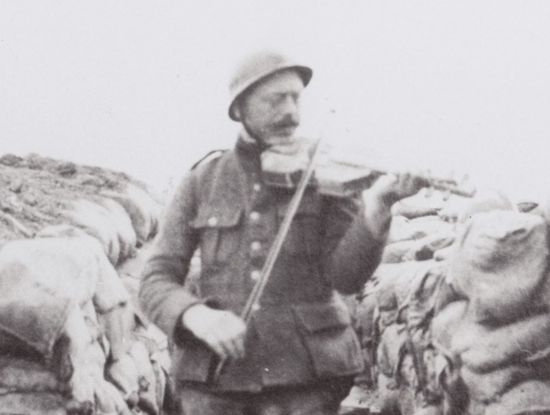
Henry Gadeyne
The Belgian violinist Henry Gadeyne (1894-1965) in the trenches.
Songs by, about, for and against the war
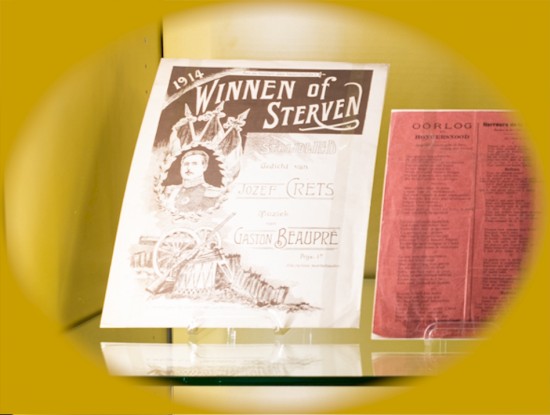
Winnen of Sterven
(Strijdlied, Gent, 1914)
This patriotic song was printed and distributed in the first month of the war. The lyricist was the Flemish man of letters Dr Jozef Crets, the composer the Ghent musician Gaston Beaupré. Jozef Crets fled to the Netherlands, where he included the verse under the pseudonym Rombout van Bruinekruis in his collection 'Belgium vrij! Verzen van den oorlog" (Rotterdam, 1917).
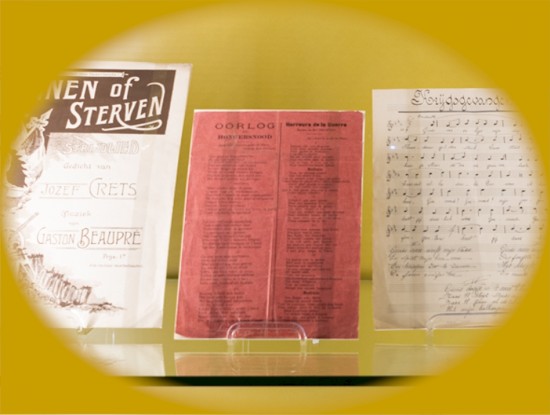
Oorlog en Hongersnood
(anon.)
Market singers responded to current events. They sang their songs on well-known melodies and sold the texts on 'flying sheets' to the audience. Probably shortly after the start of the war, this 'flying leaf' appeared, perhaps in the bilingual city of Brussels.
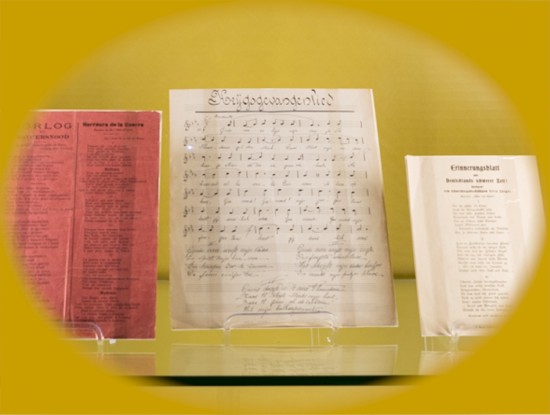
Krijgsgevangenlied
(anon.)
A song by Belgian prisoners of war in Germany, from the estate of ex-combatant Leon Bekaert.
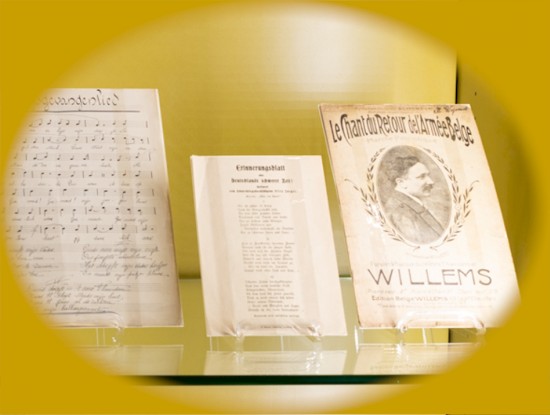
an Deutschlands schwerer Zeit
(Fritz Jaeger, Augsburg)
A song text written and sold by a war invalided Fritz Jaeger, who tells about his injury at the front in France, and calls for continuing the fight.
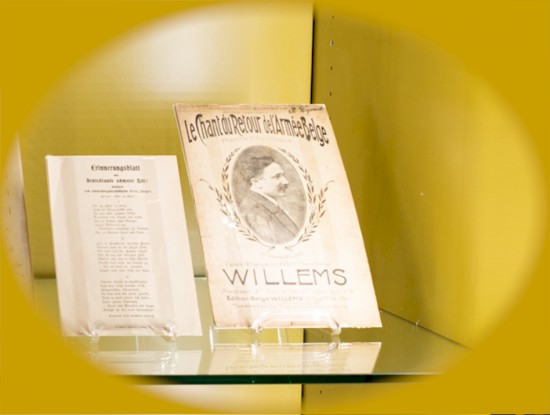
Le Chant du Retour
(Victor Willems, Paris, 1915-1917-1919)
Already in 1915, the Belgian-born but Paris-based chansonnier Victor Willems sang of the return home of the victorious troops. In 1917 he wrote a version for the Belgian army. But it was only after the war, of course, that this song became popular. "Le Chant du retour", in an instrumental version, was part of the victory parade in Paris in July 1919.
mandolin
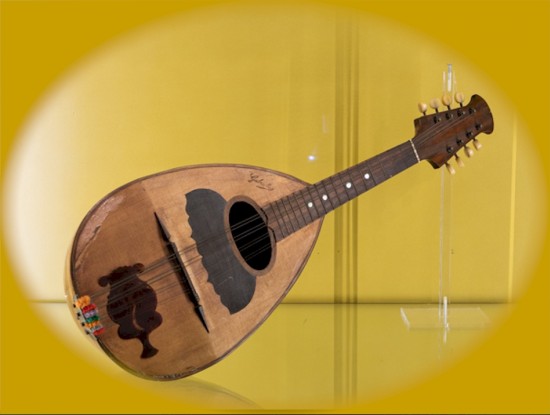
This mandolin was played by the Belgian soldier Gaston Bogaert.
flute
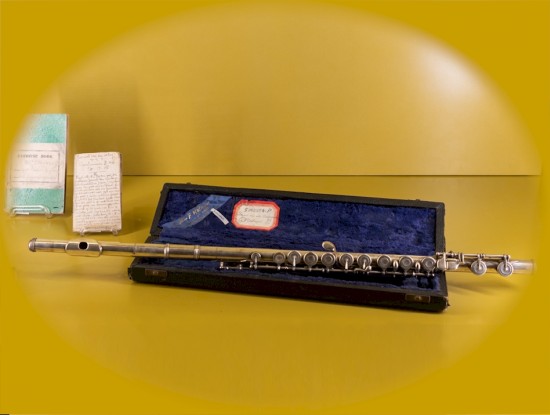
At his audition for the Symphony Orchestra of the Belgian Army (O.S.A.C.) soldier A. Cyrille Swinnen was approved for service by conductor Corneil-de-Thoran, on condition that he would be able to present a proper instrument. In January 1918 his war godmother sent him from Bordeaux this Bonneville flute.
bagpipe
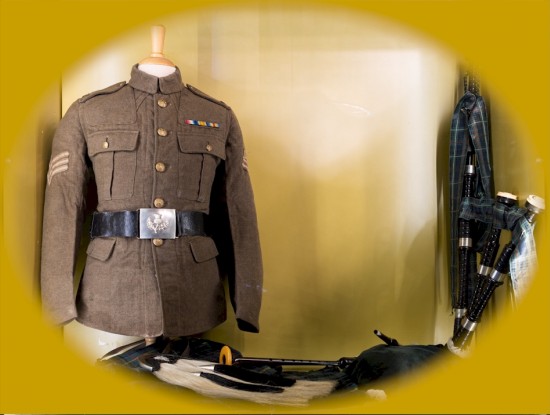
Suitcase containing the equipment, bagpipes and other personal belongings of William Beatt Martin, piper with the 9th Battalion Royal Scots.
bugles
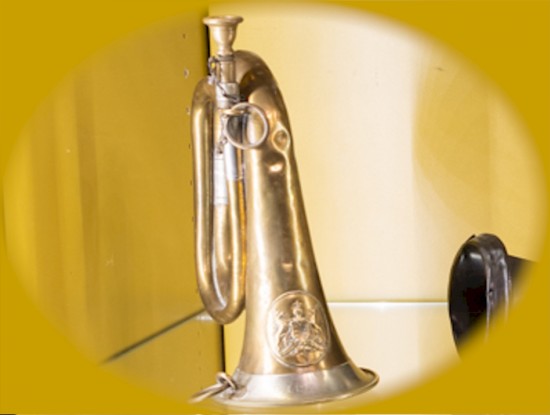
German clarion of the 122nd Füsilier-Regiment (Würtemberg).

In the mid-19th century, the firm of Charles Mahillon became the most important wind instrument factory in Belgium, and a licensed supplier to the army. His son Victor later became the first curator of the museum of musical instruments, attached to the Royal Conservatory of Brussels.

Manual engraving assigns this clarion to the Canadian soldier Harry Ogles ("Canadian Overseas Railway Construction Corps, Dixmude, Belgium, 17th Sept 1915"). But the brand name "Van Engelen - Lier" betrays a Belgian manufacture.
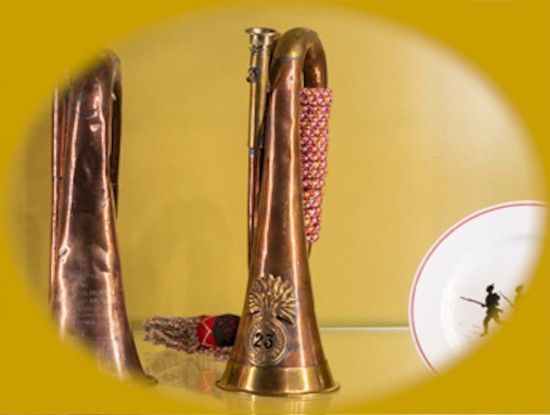
Bugle of the Royal Welsh Fusiliers. This historic regiment was given the number 23 (23rd Regiment of Foot) in 1751, when the military apparatus of the United Kingdom was standardised.

Ornamental plate with German soldiers blowing the bugle.
parade
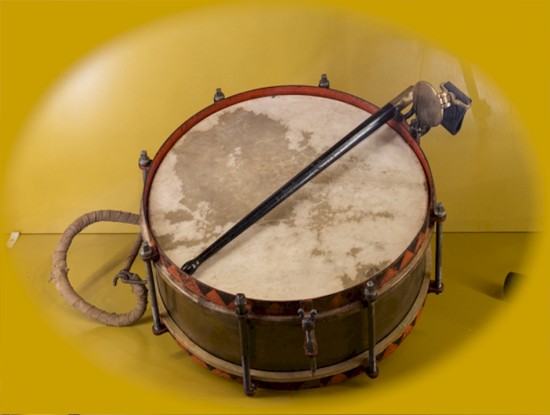
drum
German marching drum with attributes (military band).

fyfe
This fyfe is dated "1914 " and the marking on the case assigns the typical parade instrument to the 3rd squadron of the Jäger-Regiment zu Pferde Nr. 12. This unit was from January 1918 part of the 1st Landwehr-Division that was deployed from March till April 1918 (a.o. Battle of Merkem) and afterwards from May till July 1918 near Ypres (Sint-Juliaan, Hoge). How the instrument ended up with the Boone family in Turnhout will probably never be known.
music in the programme of IFFM

CD’s:
1. Kerstbestand / Christmas Truce
2. Grijsland (CD en programmaboekje)
3. Vottem (CD en catalogus)
4. In Flanders Fields (boek en CD)
5. Will ‘ye go to Flanders? De soundtrack vn IFFM#1 & TH
6. Tindersticks, Ypres De soundtrack vn IFFM#2
The Music from King Albert’s Book (i.s.m. SAMW Ieper, Michael Morpurgo)
In Flanders Fields – Naming names, 2014 (Coope, Boyes & Simpson)
Sensations of a wound, 2015 (Jim Boyes)
A Symphony of Trees
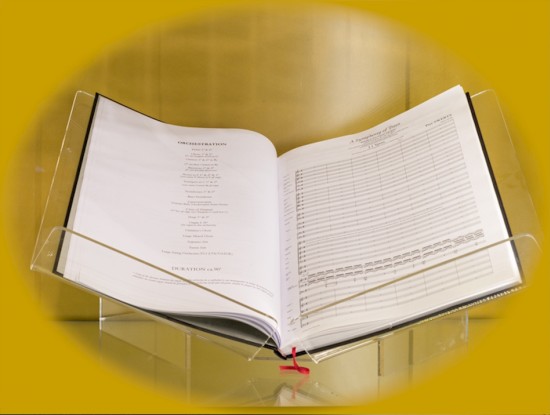
Orchestral score and programme booklet of "A Symphony of Trees.
Peace Concerts
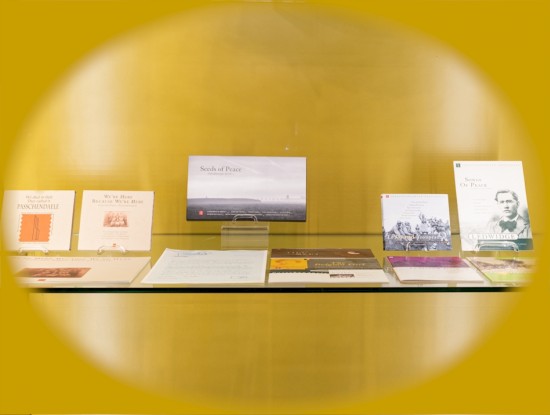
CD’s
1. We died in Hell, 1992
2. We’re here because we're here, 1995
3. Le Grand Troupeau, 2000
4. Seeds of Peace, 2005
Programme notes & invitations
1. We’re here, 1994
2. Passchendaele Suite, 1995
3. Ledwidge, 1998
4. Le Grand Troupeau, 1999 (with signatures)
5. The Belgian Girl, 2000
6. Tegenstroom, 2001
7. De Brieven, 2003 (envelope)
8. Till we meet again, 2007
Notice to the Public

As part of GoneWest, the centenary programme of the province of West Flanders, the museum returned local war stories to the communities in which they took place 100 years earlier. Afterwards, the one-off performances of these narrative concerts were reflected in a book and double-CD.
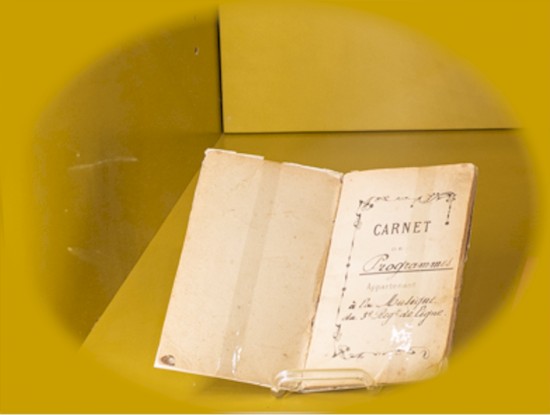
From August 1916, an anonymous musician noted down in this small notebook all 250 performances of the regimental fanfare of the Belgian 3rd Line Regiment and 180 different titles of musical works performed. The booklet provided indispensable inspiration for the 8th Notice to the Population (Vinkem, 2017).

